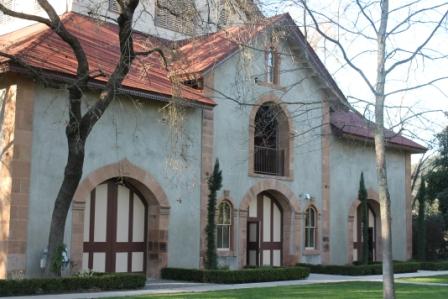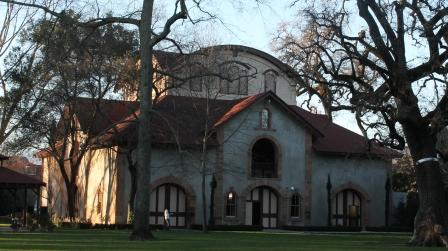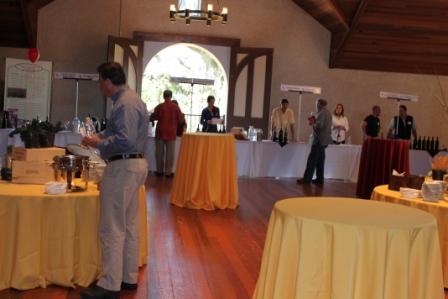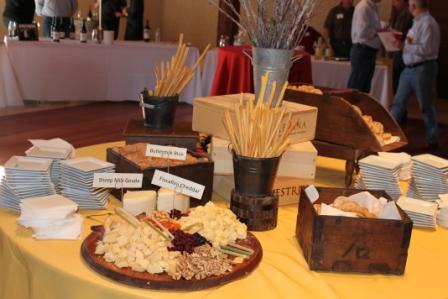Heavenly St. Helena
Posted on March 31,2012 By John Compisi
As reported in a previous article, sunny St. Helena is one of Napa’s many sub-appellations. Most people who have been there, however, would likely agree that it is probably the most historic and quaint of them all. No offense meant to the other famous and not-so famous Napa appellations. St. Helena wears the mantle “birthplace” of the Napa Valley wine industry and Charles Krug Winery, the site of this event, is noted for being Napa’s first winery. Established in 1861 by Charles Krug and purchased 8o years later by the Cesare Mondavi family in the 1940s, the Charles Krug Winery is not only historic, it is beautiful.

Charles Krug Carriage House - St. Helena (Linda C)
Most wine enthusiasts know that an Appellation and AVA are not the same. An American Viticultural Area (AVA) is a subset of an appellation. Some appellations are the name of a country, a state (such as California) or a county (e.g. Napa County). An AVA can be very small (such as Mendocino County’s Cole Ranch AVA—150 acres) or very large (such as the Ohio River Valley AVA which includes all of Indiana, Kentucky, Ohio and West Virginia.). In Napa County they range from the largest (Napa Valley—25,280 acres) to the smallest (Stags Leap District—2,700 acres). St. Helena is average in size, just over 9,000 acres, but huge in history, impact and potential. As reported previously, the ASH is the successor to the St. Helena Viticultural Society, established in 1875 but disbanded during prohibition. 128 years later, in 2004, it was reestablished as the ASH. The ASH had, at the time of this trade tasting, 50 winemaking members and 7 wine growing members. The St. Helena American Viticultural Area (AVA), was approved in 1995
As mentioned above, two recent events coordinated by the Appellation St. Helena (ASH) organization offered the opportunity to learn and experience these amazing growers and wine makers and to meet many of them. The previous event was a special Media Tasting, held at the end of 2011 at the CIA’s Rudd Center for Professional Wine Studies. The second, the 2012 Appellation St. Helena Trade Tasting, was held late last month at the Carriage House on the Charles Krug Winery grounds.

Carriage House (Linda C)
The Carriage House at Charles Krug was built in 1881 and has been recently restored. It is an amazing facility. The ASH welcome team did an amazing job of receiving the nearly 200 attendees, who represented the trades including wineries, distributors, retailers and, of course, the media. The tasting was on the second floor and the participating wineries (about 36 of them) were aligned around the perimeter of the room. There were 66 wines available for tasting including many premier wines. Strategically placed in the center of the room were appetizers and palate refreshers provided by Knickerbockers’ Catering.

Tasting Room Setup in the Krug Carriage House (Linda C)
Knickerbockers’ is one of, if not the, oldest caterers in Napa having entered the fray in 1975 as the Napa wine boom was emerging. The founder, Tony Knickerbocker, retired in 2009 and sold the business to longtime partners, Chefs Shannon and Christina Kelly. Chef Shannon Kelly trained in France under Josphe Tuet, and as Sous Chefs for Domaine Chandon’s Restaurant in Yountville. Chef Kelly’s participation in numerous wine events has exposed him to such luminaries as Dean Fairing of Mansion at Turtle Creek in Dallas, Julia Childs, Chef-Jojo of Summit Restaurant in Chicago, and Italian Television Cooking Star, Osvaldo Baroncelli. The catering offered at this tasting reflect that experience and creativity. The Knickerbockers’ team did a sensational job of keeping the food available, hot and circulating as the attendees sampled the wines and then paired it with the food.

Knickerbockers' Catering (Linda C)
There were large and well-known wineries represented as well as very small producing family owned boutique wineries. Among the larger and well-known wineries were Raymond Vineyard, Flora Springs Estate, Freemark Abbey, Trinchero Napa Valley, J. Lohr Vineyard & Wines, Robert Biale Vineyards and of course Charles Krug. Although some of the above are physically located in other appellations, the wines presented were all from St. Helena grapes. The wine making history of these wineries and estates could fill a large encyclopedia (and some have). As an example, Raymond Vineyard has been a fixture in Napa for more than five generations and is linked to the Beringer family through marriage. It is now owned by Boisset Family Estates whose local persona, Jean Charles Boisset, a real gentleman and genius marketeer, is married to Gina Gallo, of the E&J Gallo wine dynasty. The tangled family webs that vineyards seem to weave. The nature of the marketing and exposure of these wineries prompts me to focus on the smaller and lesser known. Do not misunderstand, despite their size and stature, these winery families like Boisset and Krug/Peter Mondavi (represented at this event by grand-daughter Alycia Mondavi) remain very personally involved and continue to work to maintain their strong reputations.
Among the lesser known, to this writer, were Ballentine Vineyards (an amazing and long history in Napa dating back over 100 years), Boeschen Vineyards (only 13 years old), Calafia Cellars, Crocker & Starr Wines and Varozza Vineyards. Except for Ballentine (about 10,000 cases), each of these small select wineries produces between 150 and 1000 cases. Each of them offered samples of 1 or 2 of their portfolio and these, among so many at this event, stood above. Again, there were many more whose wineries were excellent.
Ballentine, by far the largest of the small producers listed here, produces seven varietals wines including, Malvasia Bianca (believed to be of Greek origin), Cabernet Sauvignon, Zinfandel, Cabernet Franc, Chenin Blanc, Petite Sirah and Petite Verdot. Van Ballentine was there and poured the 2007 Petite Verdot which was full and robust with exceptional color and tannic structure. The fruit and floral aspects of the 2009 Petite Sirah, Fig Tree Vineyard was to die for! It is now clear why Ballentine has such a long history.
Shawn Heffernan, winemaker and brother-in-law to Doug and Dann Boeschen, represented Boeschen Vineyards at this event. Boeschen produces about 500 cases annually from estate grapes grown on their 7 acres. The four wines produced are Cabernet Sauvignon, Sauvignon Blanc, a Rosé (100% Merlot) and a Bordeaux blend called Carrera. All of the limited production (almost totally sold out with ~72% sold through their wine club) wines poured were big, elegant and silky in mouth feel (2008 and 2009 Estate Cabernet and 2009 Carrera blend).
Calafia Cellars may have the most fascinating name. Calafia is a legendary goddess from the West Indies, logged in Christopher Columbus’s log book, and referred to by Cortez when he named the land we know as Baja California. By extension, California is named after Calafia. Randall (pouring at the event) and Mary Lee Johnson have been making wine under the radar for over 30 years. Only producing about 150 cases, Randall, the winemaker, earned his chops during 35 years in Napa culminating as winemaker at Stags’ Leap and now as a winemaker at Hess Collection. The 2007 Napa Valley Meritage, La Reina, is a Bordeaux blend of Cabernet Sauvignon, Malbec and Petite Verdot. The flavors and color were rich with full spectrum aromas of blackberry and currants.
Crocker & Starr is owned by Charlie Crocker (Crocker Bank, etc) and Pam Starr winemaker since inception) and was established as a bonded winery in 1997. Charlie has owned and farmed the 100 acres of vineyards in St. Helena since the early 1970s. First release, a Cabernet Franc, was released in 1999. Ms Starr has worked in the industry for years including being winemaker at Carmenet and Spottswoode. They produce about 1000 cases – total – of Cabernet Sauvignon, Cabernet Franc and Sauvignon Blanc. The 2008 Cabernet Sauvignon has intense flavors and structure and can continue to age for years to come. The 2009 Cab Franc has such dark plum colors that it almost appears black. The cola flavors and aroma were evident with a tobacco tone throughout. This wine can remain on your shelf for another 15 years. Tasting room opened in 2009, call for hours.
Finally, Varozza Vineyards, another century old family operation spanning four generations. The ~40 estate produces grapes of 8 different varietals but the wines made by Varozza are dedicated to Cabernet Sauvignon and Petite Sirah. The winery produces about 550 cases annually. They sell most of their grapes to other prominent Napa Valley producers. Varozza was pouring the 2008 Cabernet and Petite Sirah. Both were very balanced with lush flavors, characteristic of the respective varietal, and rich in color and mouth feel with a long supple finish.
The net-net of this event is the determination that one needs to spend more time discovering and enjoying the wines and wineries of St. Helena. The heritage is rich and the wines are equally so. Be they large and famous or small and less well-known, the wineries of St. Helena deserve your attention.